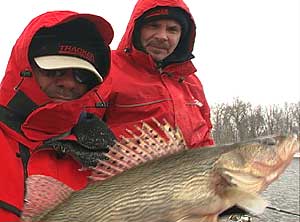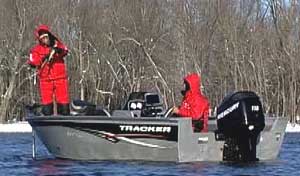 You’ve heard or read me discuss it before, the fact that there are good opportunities for open water walleye fishing even in the middle of winter. One of the most popular locations for this is near the town of Red Wing, Minnesota on the Mississippi River. Just above the dam at Red Wing is a power plant that discharges warm water and helps to keep the river open for at least three to four miles below the dam all winter. That’s where Keith Kavajecz and I headed for our final TV shoot of the year last season as we were wrapping up production for the 2006 episodes of The Next Bite TV. While this stretch of river does hold some really nice walleyes, it’s the sauger fishing that excels here, especially this time of year. Our presentation of choice on this outing would be vertical jigging, but with a twist.
You’ve heard or read me discuss it before, the fact that there are good opportunities for open water walleye fishing even in the middle of winter. One of the most popular locations for this is near the town of Red Wing, Minnesota on the Mississippi River. Just above the dam at Red Wing is a power plant that discharges warm water and helps to keep the river open for at least three to four miles below the dam all winter. That’s where Keith Kavajecz and I headed for our final TV shoot of the year last season as we were wrapping up production for the 2006 episodes of The Next Bite TV. While this stretch of river does hold some really nice walleyes, it’s the sauger fishing that excels here, especially this time of year. Our presentation of choice on this outing would be vertical jigging, but with a twist.
As with any fishing situation, locating the majority of the fish is key to success. On rivers this time of year, it’s important to find the deeper holes. That means outside bends, deep sections of the main channel, wash-out holes off wing dams, anywhere there’s deeper than average water will likely hold the most fish. The exception would be when fish move to shallow shoals or flats for short feeding binges. These shallow bites can be dynamite, however are typically limited to very brief periods early and late in the day. If your timing is right, pitching small jigs and plastics to these spots can yield some great action. However, the most consistent fishing will be in the deeper holes where vertical jigging reigns.
Most of the saugers we caught on this particular trip were relating to holes in the main channel. Anytime you’re working river structure like this it is key to determine what section of the hole the fish are holding in. Sometimes it will be the head of the hole, sometimes the tail end of the hole. Anytime you’re fishing this type of spot keep in mind that the fish will rarely be active when sitting in the bottom of the hole. The more active biters will generally be found on the edges, where they can easily move up and down as needed to contact feeding opportunities. This time around, we were contacting most the fish on the breaks down the sides of the holes. An ideal situation for a vertical jigging approach, because it allows you to efficiently slip downstream covering various depths along the break until you contact fish.
There’s been a huge shift the past couple of years when it comes to cold water river walleye fishing. Late fall and winter was once thought to be the sole domain of the "jig and minnow" presentation. Walleyes and saugers are not necessarily real active in these colder water environments, but they do tend to be concentrated in good numbers in relatively defined areas. The subtle attraction of the jig and live minnow vertically jigged right in front of their noses has historically proven to be both effective and efficient for catching fish. This scenario, played out over the course of past years, was traditionally the research and development ground for many of the more popular innovations in jig and "stinger hook" designs used today. It also was where Keith Kavajecz and myself began to fine tune our preferences for jig fishing tackle and presentation techniques such as "two-rod jigging".
These days river rats are still fine tuning their craft on these waters, setting aside their minnow buckets in favor of artificial tails. You might think it’s because they’re tired of frosty fingers from dipping in the bait bucket, or fed up with one too many spilled minnow pails leaving the boat’s floor as slick as an ice rink. The real reason plastic tails are getting so much attention amongst these winter walleye warriors is because they catch fish!
 That was our plan on this trip. To vertical jig the river using artificial tails to find out if in fact, under the toughest of conditions, live bait was unnecessary. And make no mistake about it; conditions were tough … on us anyway. It had been one of the coldest Decembers on record, and while we were blessed with a "window of warmer weather", the temps were still below freezing and as we pulled in to Red Wing we were greeted with six inches of fresh snow.
That was our plan on this trip. To vertical jig the river using artificial tails to find out if in fact, under the toughest of conditions, live bait was unnecessary. And make no mistake about it; conditions were tough … on us anyway. It had been one of the coldest Decembers on record, and while we were blessed with a "window of warmer weather", the temps were still below freezing and as we pulled in to Red Wing we were greeted with six inches of fresh snow.
Believe me, we were not breaking new ground here (although we did have to break a little ice to get from the ramp to the river channel). Local anglers on this stretch of river have been using jig and artificial tail combinations longer than most other anglers across the walleye belt. But we were armed with a variety of tails, both new and old, to try and see what would trigger these cold water fish.
Since companies like Berkley have begun making tails specially designed for walleyes, with softer materials that impart good action, shapes and colors that closely mimic live bait and impregnated scents formulated to specifically attract walleyes, more and more anglers are discovering that the live bait can be left in the bucket. Some of what we found on this particular trip was no real surprise. Tails like Berkley’s three and four inch GULP! Minnow and Berkley Realistix Power Minnow got plenty of bites.
Many fishermen on this pool of the Mississippi swear by the four inch ringworm, and we did catch a few fish on those, although they tend to work better for casting to shallow feeders than for vertical jigging.
Perhaps the biggest surprise of the outing was a bait Keith rigged up, one not at all designed for walleyes, but best known as a finesse bait for bass; the Berkley four inch GULP! Noodle! I really have no idea why he even slipped it on his jig, but once I saw the action the bait had as it dropped in the water, I immediately knew why it worked. The Noodle is a stiffer bait than the others, and that coupled with its stick-like shape, gave it a smooth gliding action when jigged. I wouldn’t say that the Noodle is that new best walleye bait on the market, but in tough conditions, a subtle change in action can often be just what’s needed to get the Next Bite.
Although the fish we caught on this show were not big, there was good action. We caught a lot of feisty saugers, and a few nice ones did manage to make it on camera (when we weren’t having trouble with the video gear freezing up on us). And we caught them all with out using any live bait! Fishing these open water stretches of river in winter can be brutal weather-wise, but if you put yourself in the right spot and arm yourself with the right baits, the fish catching, along with not having to dip your hands in a minnow bucket every few minutes, will help keep you warm and make winter seem that much shorter. Of course several layers of warm clothes don’t hurt either.
Good luck and good fishing!










